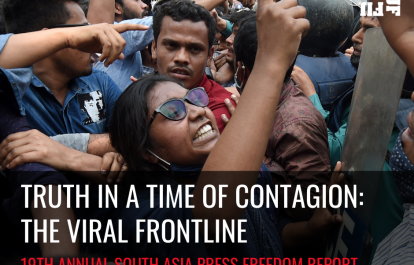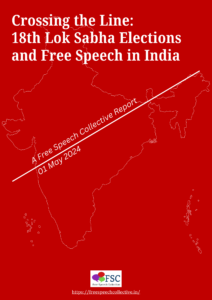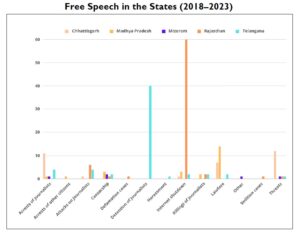The International Federation of Journalists (IFJ) on behalf of the South Asia Media Solidarity Network (SAMSN) launched the 19th annual South Asia Press Freedom Report entitled “Truth In a Time of Contagion: The Viral Frontline” at 12:30 pm (New Delhi time) on May 3, 2021, World Press Freedom Day. The launch was held online.
The report includes analysis on the situation of press freedom in every South Asian country, lists of detained journalists in South Asia, details of media rights violations and an interview with journalists’ union leaders in South Asia.

The following is an excerpt from the India chapter of the report.
RESISTING THE ONSLAUGHT ON MEDIA RIGHTS
The coronavirus pandemic raging since 2020, seemed to have presented the Indian government with an opportunity to further clamp down on the media. The message was clear: highlight the failings of the government in the handling of the pandemic and face the consequences.
The year was marked by the heavy-handed use of laws of sedition, anti-terror or disaster management to quell criticism of the government whether at the Centre or in states, on journalists or civil society. This clampdown on journalists was marked during the ongoing peaceful farmers’ protest against three farms laws that has left the government more than rattled.
The passing of the controversial Information Technology (Guidelines for Intermediary and Digital Media Ethics Code) Rules 2021 to control the increasingly influential digital media extensively accessed by burgeoning mobile phone users across the country is yet another nail in the coffin of freedom of expression. The rules will not only increase censorship and impact press freedom but will exercise powers far beyond the parent legislation for digital new media. It will greatly impinge on the right to free speech and will impact the independent functioning of digital/online media. DIGIPUB, an association of 11 digital news media publishers in response to the new IT Rules, 2021, DIGIPUB said any attempt by the executive to regulate the content of news portals or publications would be to “strike not only at the constitutional scheme but at democracy itself”. DIGIPUB has also challenged the new IT Rules in court.
However, intolerance of dissent is not new. The threat to freedom of press and the government’s control over the media increased not long after the Bharatiya Janata Party-led National Democratic Alliance (NDA) took over the reins of power in 2014. Things became more ominous after the NDA returned to power with a thumping majority in 2019 and the government went about amending laws in a bid for more centralisation. These included amendments to the Unlawful Activities (Prevention) Act, National Investigation Agency Act and the Right to Information Act among others. While these laws had direct implications for the media, what was worse was the division of the media into two distinct camps—one, and a significant section at that, which was unquestioningly pro-government, and the other which tried to maintain its independence.
It is perhaps not for nothing that the Freedom House Report, 2021, titled ‘Democracy under siege’ states: “The fall in India’s rankings could have a particularly damaging impact on global democratic standards.
According to the report, “The private media are vigorous and diverse, and investigations and scrutiny of politicians do occur. However, attacks on press freedom have escalated dramatically under the Modi government, and reporting has become significantly less ambitious in recent years. Authorities have used security, defamation, sedition, and hate speech laws, as well as contempt-of-court charges, to quiet critical voices in the media. Hindu nationalist campaigns aimed at discouraging forms of expression deemed “antinational” have exacerbated self-censorship. Online disinformation from inauthentic sources is ubiquitous in the run-up to elections. Separately, revelations of close relationships between politicians, business executives, and lobbyists, on one hand, and leading media personalities and owners of media outlets, on the other, have dented public confidence in the press.”
In 2020, dozens of journalists whose reporting was critical of the government’s handling of the coronavirus pandemic were arrested, and media outlets faced pressure to praise the government’s response.
DEEP CLEAVAGES
Over the past seven years, India has witnessed an unprecedented push to polarise the country’s diverse society, its key strength through the ages. In its religious, community and caste-driven polarisation, the government has particularly targeted the media to weaken the institution, a vital pillar of democracy. The media, cutting across all formats today appear to be irrevocably divided into a largely compliant and pro-government on the one hand and a miniscule but strong independent, mostly digital media.
Some corporations have other businesses to protect and cannot afford to fall foul of the government and other media houses are directly financed by entities sympathetic to the government. Indeed, divisive politics has deeply influenced not only the civic sphere but also the media environment in India with the government pitting one against the other, which has enabled it to promote its chosen narrative with utmost ease. It has also increasingly emboldened the government to curb the freedom of press whenever such an opportunity presents itself. One such opportunity was the Covid-19 pandemic.
PANDEMIC EFFECT
It was against such a dismal backdrop that the coronavirus pandemic struck with full force in the early half of 2020, bringing in its wake more miseries for the media: retrenchments, salary cuts and in some cases even closures.
The economic crisis in the media industry brought about by an ad revenue crunch singed small and big groups alike; managements across the country went on a pay-cut and retrenchment spree while some smaller editions of the larger newspapers had to even shut shop plunging many journalists into what at the time seemed like a bottomless abyss.This happened despite India’s Ministry of Labour and Employment issuing a circular on March 20, 2020 to public and private employers advising them not to terminate services of employees or reduce wages.
The Uttar Pradesh (UP) government suspended The Working Journalists Act, as part of suspending other labour laws in the state on May 8, 2020. The move was significant for the press in India because most news media companies reporting from Delhi are based in the suburb of Noida in UP which is part of the National Capital Region.
On its part, the Indian Newspaper Society wrote to the Ministry of Information and Broadcasting twice, the last being on April 25, 2020 demanding a two-year tax holiday, increase official advertisement rates and budget spending on the sector. This request was not granted.
GRIM TALLY
But worse was to follow, with the pandemic taking grip across the globe. According to data published by the Press Emblem Campaign (PEC) , a Geneva-based NGO with special consultative UN status founded by journalists of several countries, since the beginning of March, which is when they started tracking till December 26, 585 journalists had died in 57 countries. India was the second-most affected with 53 deaths, following Peru with 93 deaths.
The PEC study stated that safety of media workers was particularly at risk as journalists had to continue to provide information on the ground and that a number of journalists died “for lack of adequate protective measures when doing their job”.
The year witnessed a grim headcount as media colleagues succumbed to the virus: young and old, reporters, editors, photojournalists and media administrators, no one was spared. Kanpur-based television journalist Neelanshu Shukla,30, associated with AajTak ; Siliguri-based senior journalist in Himalaya Darpan, Mani Kumar Rai, Malayala Manorama’s senior journalist; D Vijayamohan; poet and journalist Manglesh Dabral; Delhi-based senior journalist Rajiv Katara; Noida-based Pankaj Shukla; Delhi-based senior journalist Rakesh Taneja; Bhubaneswar-based television journalist Prabir Kumar Pradhan; Tripura-based Jitendra Debbarma; Mysuru-based Pavan Hettur; Patna-based photojournalist Krishna Mohan Sharma; Assam-based journalist Dhaneswar Rabha; Ludhiana-based veteran journalist Ashwani Kapoor; All India Radio news presenter from Guwahati Golap Saikia; Indore-based senior journalist Manoj Binwal were only a few of the long list of scribes who succumbed to the deadly virus.
In its latest statement released on April 24, 2021, the Press Emblem Committee put the tally of Indian journalists lost to Covid as over 100, at a time when the global figures had crossed 1175 journalists in 76 countries.
According to one study #RateTheDebate ‘on an average one journalist died every day in April 2021’. The largest number of deaths are said to be in the states of Uttar Pradesh, Telangana and Maharashtra and most hail from districts.
Figures compiled by the Network of Women in Media, India (NWMI), reveal a bleak tally of 173 and counting, journalists and media workers in India lost to Covid.
It is clear that no one is untouched. As India is lashed with a deadly second wave of Covid, and ever mutating strains, reporters and photojournalists continue to report from the field against great odds, often without adequate protective equipment. Many desk staff were not permitted to work from home for their own safety. Few media houses extended insurance cover to those who were ill or deceased. Only a few states such as Andhra Pradesh,
Telangana and Tamil Nadu have prioritised journalists as frontline workers who must be prioritised for the vaccine. The plea of journalist unions and organisations to the Central government to declare journalists as frontline workers and give priority for vaccination to facilitate their carrying out their duties has drawn a deafening silence.
A confirmation of the rising number of cases can be got from the number of applications the ‘Journalists Welfare Scheme’ of the Press Information Bureau (PIB), under the Union Information & Broadcasting Ministry. So far, in past 6-8 months, in its drive to help families of journalists who passed away due to Covid, (monetary compensation of Rs 500,000, the PIB has got 80 plus applications.
(Download the full report :


